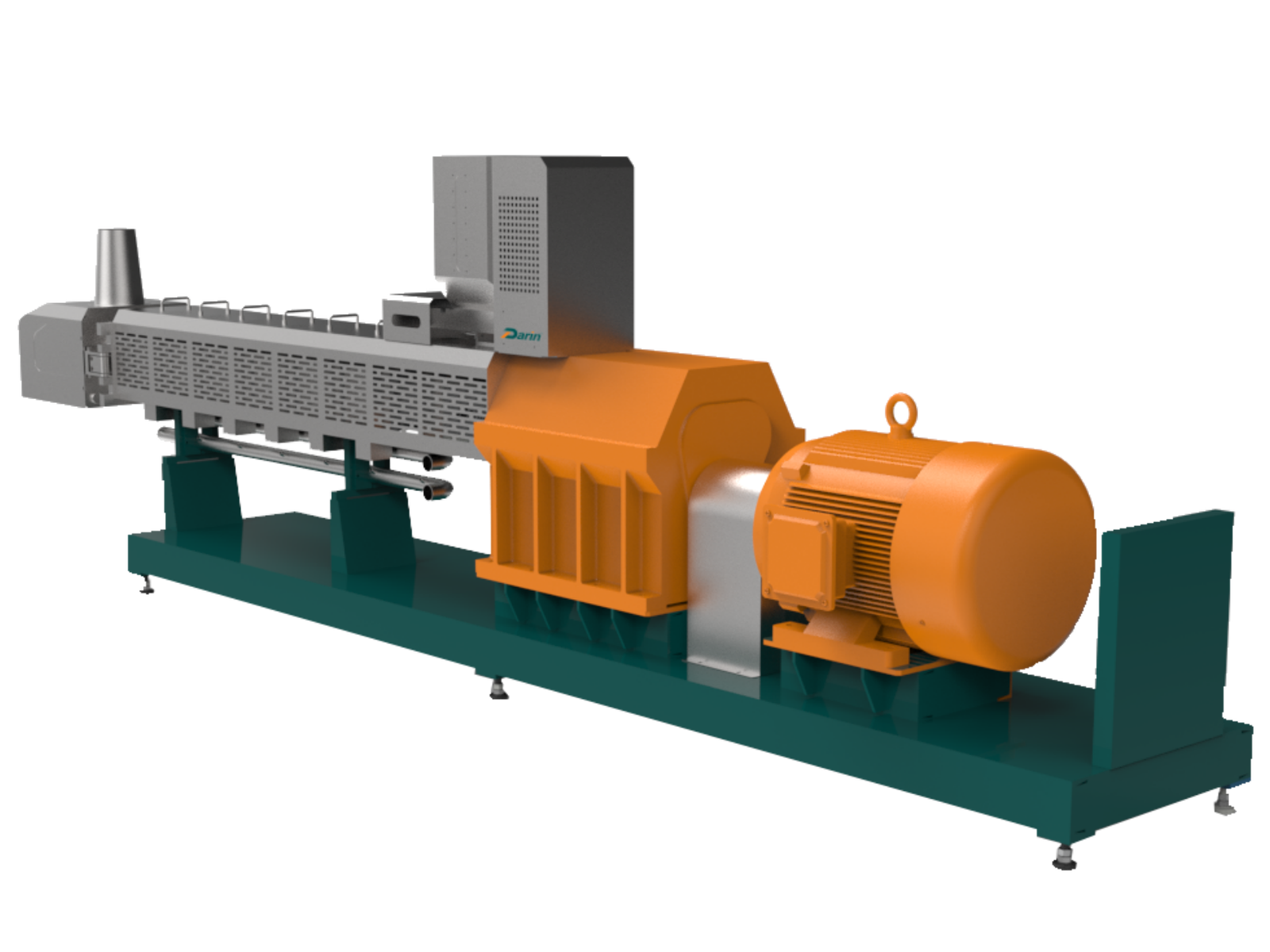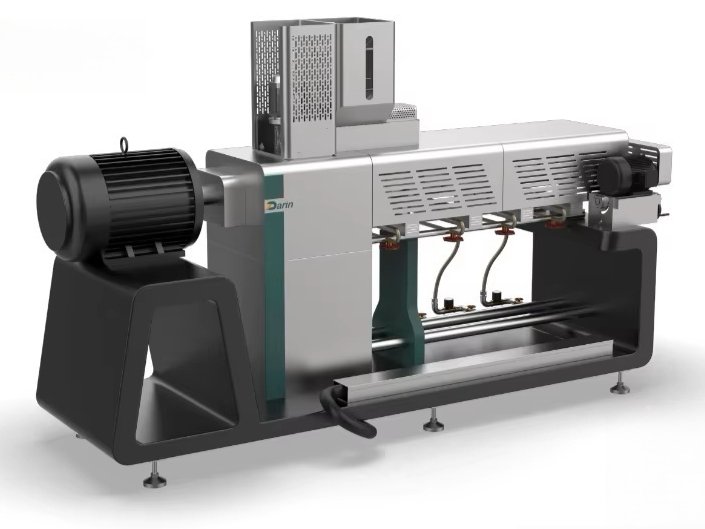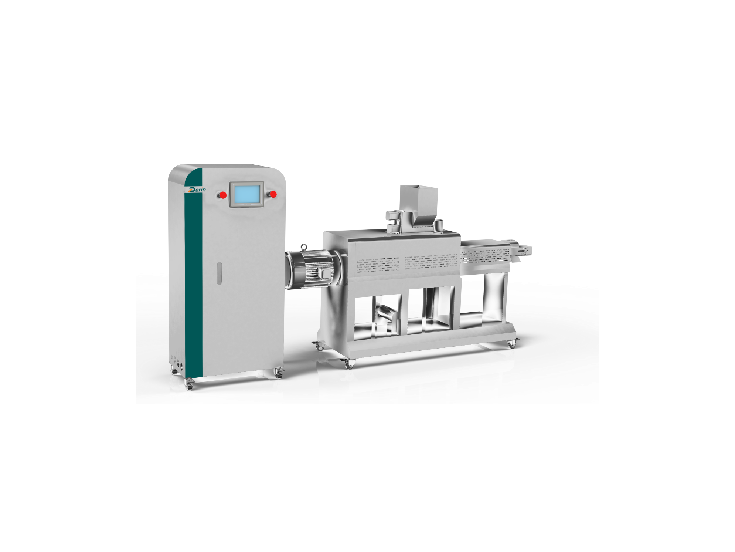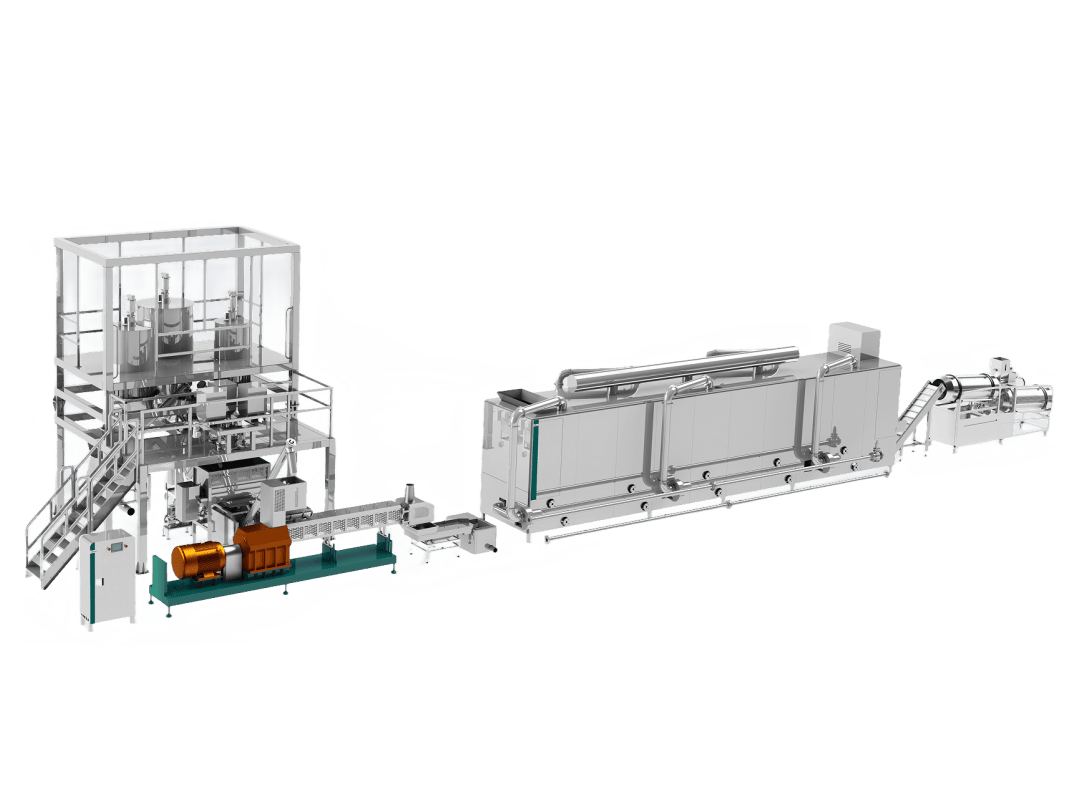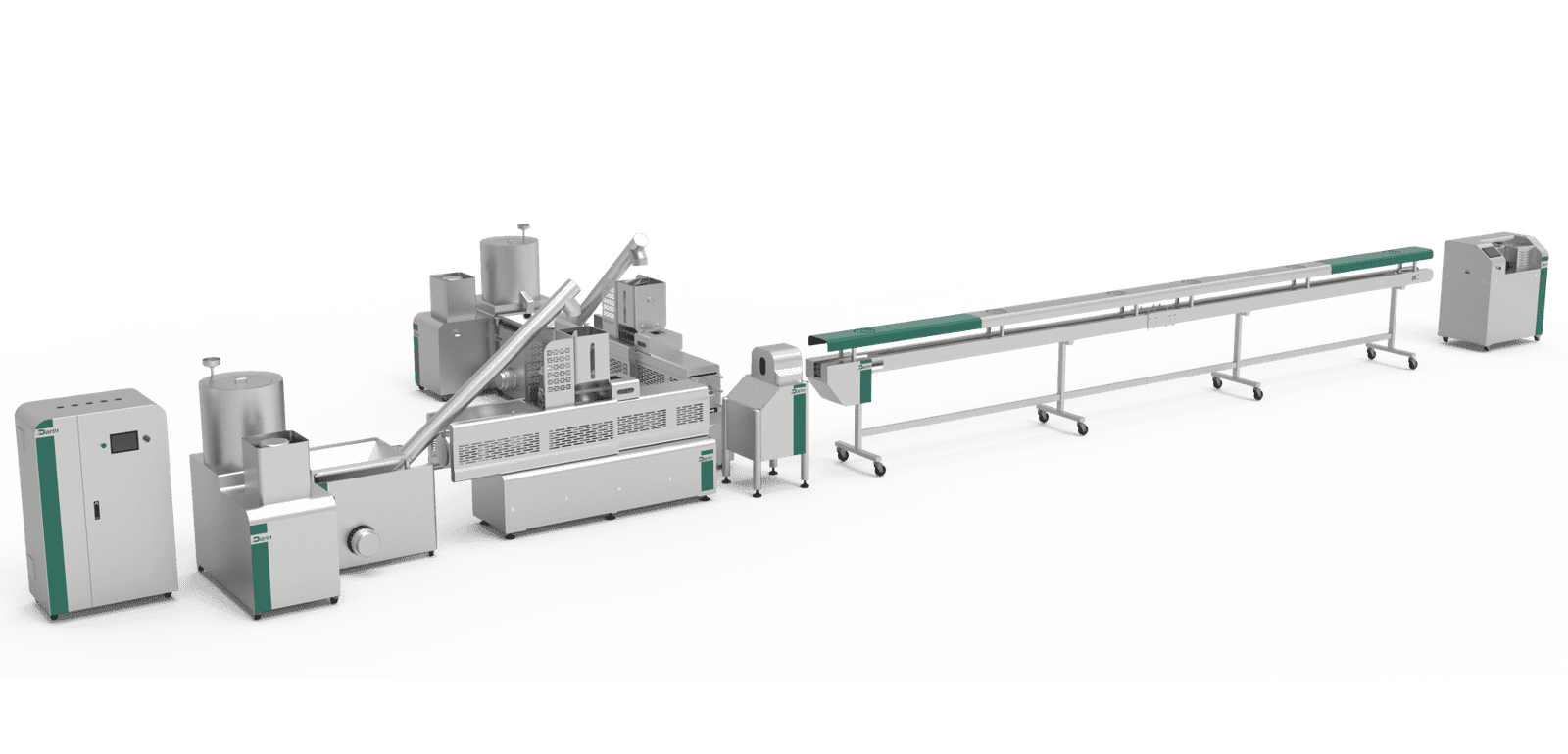
Starting a dog chew production business is exciting—but choosing the right production line can be a complex, high-stakes decision. Many investors and factory owners struggle with mismatched capacity, unnecessary automation, or poor material compatibility that lead to waste, downtime, and lower product quality. Inconsistent output or frequent breakdowns can cripple profit margins and damage a brand’s reputation.
The right production line, however, can transform your operations. A properly sized, well-configured line ensures continuous output, low maintenance, and consistent chew texture—whether you produce starch-based dental sticks, rawhide bones, or co-extruded filled treats. This guide provides a detailed, engineer-level roadmap to help you select the ideal line for your factory’s goals.
Choosing the right dog chew production line involves evaluating your product type (starch, meat, rawhide, co-extruded), production capacity, automation level, ingredient compatibility, drying technology, energy efficiency, and compliance standards. The optimal line should balance cost, flexibility, and reliability to deliver consistent output, meet hygiene regulations, and scale with your business growth.
Many first-time manufacturers only compare prices or advertised capacities without understanding key engineering details like extruder configuration, drying curves, or material feeding systems. The following 12 steps—based on Darin Machinery’s decades of global experience—will walk you through every technical factor to ensure your investment delivers long-term value and performance.
All dog chew machines are identical, regardless of brand or configuration.False
Dog chew production lines differ in screw design, heating zones, moisture control, and automation systems—each optimized for specific chew types and throughput levels.
Step 1. Define Your Product Type and Formula
Your first decision is what kind of dog chews you plan to produce. Product type determines extrusion pressure, mixing ratio, and dryer configuration.
| Chew Type | Structure | Main Raw Materials | Texture | Shelf Life | Production Method |
|---|---|---|---|---|---|
| Starch-Based | Extruded dense stick | Corn/potato/tapioca starch | Firm, elastic | 12–18 months | Twin-screw extrusion |
| Rawhide Chew | Layered natural hide | Cow/buffalo hide, gelatin | Hard | 12–24 months | Rolling + drying |
| Meat-Based Chew | Co-extruded core-shell | Meat meal, collagen, starch | Soft | 6–12 months | Co-extrusion |
| Dental Stick | Textured ridges | Starch, calcium, mint | Firm | 12–18 months | Extrusion with shaped die |
Tip: Identify your product mix early. A starch-based line can be adapted later for dental or co-extruded chews, but not for rawhide.
Step 2. Determine Your Production Capacity
Capacity planning defines both initial investment and operational cost.
| Production Scale | Output (kg/h) | Suitable For | Labor | Area Required (m²) |
|---|---|---|---|---|
| Pilot Scale | 100–200 | R&D, startups | 1–2 | 200–300 |
| Medium | 300–600 | SMEs, multi-SKU | 3–4 | 500–800 |
| Industrial | 800–1500 | Export factories | 4–6 | 1000–1500 |
Engineering Insight:
The drying section typically limits throughput. For every 100 kg/h increase in extrusion, allocate ~6–8 m² more drying area.
Step 3. Choose the Right Extruder Type
Extrusion defines product structure, energy efficiency, and quality.
| Extruder Type | Characteristics | Application | Cost Range (USD) |
|---|---|---|---|
| Single-Screw | Simple, low cost | Basic shapes | 15,000–30,000 |
| Twin-Screw | High shear, self-cleaning | Multi-shape, co-extruded | 45,000–80,000 |
| Co-Extruder | Two synchronized screws | Filled or dual-color treats | 60,000–100,000 |
Technical Parameters:
- Screw speed: 200–500 rpm
- Barrel zones: 5–8, each with PID temperature control
- Power: 22–75 kW depending on capacity
Recommendation: For flexible production, choose twin-screw with modular screws and interchangeable dies.
Step 4. Assess Mixing and Feeding Systems
A stable feed system ensures homogeneous dough and constant extruder load.
Equipment Checklist:
- Ribbon Mixer (dry blend)
- Vacuum or paddle mixer (liquid incorporation)
- Preconditioner (optional steam hydration)
- Screw or pneumatic feeder (continuous dosing)
Key Metrics:
| Parameter | Target | Impact |
|---|---|---|
| Moisture Uniformity | ±1% | Prevents pressure fluctuation |
| Mixing CV | ≤5% | Consistent texture |
| Batch Cycle Time | 3–6 min | Output rate control |
Darin recommends an automatic weighing-mixing system for recipes with glycerin or gelatin to minimize operator error.
Step 5. Evaluate Shaping and Cutting Options
Different shapes require corresponding dies and cutters.
| Cutter | Operation | Accuracy | Ideal Product |
|---|---|---|---|
| Rotary Cutter | Continuous | ±1 mm | Sticks, rods |
| Guillotine | Intermittent | ±0.5 mm | Bone or cube |
| Twister | Servo twist | ±1° | Dual-color twisted sticks |
| Embossing Roller | Heated imprint | — | Dental ridges |
Important: Confirm that die plates are made of hardened stainless steel (HRC > 50) for longevity.
Step 6. Select Appropriate Drying Technology
Drying controls moisture, texture, and shelf life.
| Dryer Type | Capacity Range (kg/h) | Energy Source | Pros | Cons |
|---|---|---|---|---|
| Multi-Layer Belt Dryer | 300–1500 | Electric/steam | Continuous, uniform | High initial cost |
| Hot-Air Oven | 100–400 | Electric | Compact, simple | Batch, manual |
| Microwave Dryer | 100–500 | Electric | Fast, soft texture | High power demand |
Design Reference:
- Temperature: 80–120 °C
- Drying time: 1.5–3 h
- Final moisture: ≤12 %
Dog chews can be sun-dried safely at industrial scale.False
Controlled hot-air drying is required to prevent microbial contamination and ensure uniform moisture distribution.
Step 7. Examine Cooling, Inspection, and Packaging Systems
After drying, chews must cool gradually to ≤35 °C before packaging.
Cooling Options:
- Air-cooled stainless conveyors (10–30 min)
- Dehumidified chambers for humid climates
Inspection Tools:
- Metal detector (Fe ≥ 0.8 mm)
- Check weigher (±1.5 %)
- Optical sorter (optional for premium lines)
Packaging Machines:
| Type | Speed (packs/min) | Features |
|---|---|---|
| Pillow Wrapper | 60–120 | Continuous flow |
| Rotary Bag Packager | 30–60 | Zipper, nitrogen flush |
| VFFS Machine | 40–80 | Multihead weigher integration |
Step 8. Analyze Automation and Control Systems
Automation defines productivity and repeatability.
Core Components:
- Siemens or Omron PLC with HMI touch screen
- Temperature, torque, and moisture sensors
- Data logging for HACCP traceability
- Ethernet/IoT remote monitoring
Automation Levels:
| Level | Description | Example |
|---|---|---|
| Basic | Manual feed, semi-auto packaging | Entry startup line |
| Standard | Automatic mixing, continuous drying | SME factory |
| Advanced | Full PLC integration, remote control | Export-grade plant |
Automation reduces labor cost by 30–50 % and minimizes human error.
Step 9. Consider Utility Requirements and Energy Efficiency
Before purchasing, ensure your facility can support the line’s utilities.
| Utility | Requirement (Typical 500 kg/h Line) |
|---|---|
| Electricity | 90–100 kW connected load |
| Steam (if preconditioner) | 0.3–0.5 MPa, 200 kg/h |
| Compressed Air | 0.6 MPa, 0.3 m³/min |
| Cooling Water | 2–4 m³/h (closed loop) |
Energy-Saving Features:
- Variable-frequency drives (VFD) on fans and motors
- Heat recovery from dryer exhaust (10–15 % savings)
- Insulated panels and automatic shutoff valves
Step 10. Verify Material and Sanitation Standards
Ensure all contact parts meet food-grade standards:
| Component | Material | Certification |
|---|---|---|
| Product surfaces | SS304/SS316 | FDA / CE |
| Gaskets | Silicone | Food-grade |
| Belts | PU or PTFE | HACCP compliant |
| Wiring | IP65 sealed | Wash-down safe |
Lines should support CIP (Clean-in-Place) and tool-free disassembly for daily sanitation.
Step 11. Review Certification, Warranty, and Support
Global buyers must meet regulatory standards:
| Region | Required Certification |
|---|---|
| EU | CE + HACCP |
| USA | FDA CFR Title 21 |
| China | Feed additive registration |
| Middle East | Halal compliance |
Ask your supplier for:
- One-year full warranty (parts and labor)
- Lifetime technical support
- Remote PLC diagnostics
- Local agent or service partner availability
Step 12. Compare Cost, ROI, and Supplier Credibility
12.1 Estimated Investment
| Line Capacity (kg/h) | Price Range (USD) | Typical ROI |
|---|---|---|
| 200–300 | 80,000–130,000 | 16–20 months |
| 500–600 | 150,000–230,000 | 12–15 months |
| 800–1000 | 200,000–300,000 | 10–14 months |
12.2 Evaluation Checklist
| Factor | Weight (%) | What to Check |
|---|---|---|
| Machine Quality | 25 | Material, welding, wiring |
| Energy Efficiency | 15 | Dryer insulation, VFD |
| Flexibility | 15 | Die change system |
| After-Sales Support | 20 | Training, spare parts |
| Cost/ROI | 25 | Profitability projection |
12.3 Supplier Assessment
- Visit factory or request live video test.
- Ask for at least two client references.
- Confirm real operating videos (not stock footage).
- Review warranty terms in writing.
Step 13. Example Configurations
| Section | Model | Power (kW) | Output (kg/h) |
|---|---|---|---|
| Mixer | DR-MX500 | 7.5 | 500 |
| Extruder | DR-65 Twin-Screw | 45 | 500 |
| Cutter | DR-CUT | 1.5 | — |
| Dryer | DR-DRY | 36 | 500 |
| Cooler | DR-COOL | 2 | — |
| Packager | DR-PACK | 3.5 | 60 packs/min |
Total Power: ~95 kW Factory Area: ≈ 900 m²
Step 14. Common Mistakes to Avoid
- Over-specifying capacity – Unused capacity inflates cost and utilities.
- Ignoring ingredient compatibility – Not all lines handle high-gelatin formulas.
- Neglecting drying space – Dryer sizing is critical for stability.
- Choosing by price only – Cheap machines often lack food-grade design.
- Underestimating after-sales service – Downtime costs more than purchase price.
Step 15. Future-Proofing Your Investment
- Opt for modular lines that allow new dies or co-extrusion upgrades.
- Consider IoT-enabled monitoring for predictive maintenance.
- Use digital recipe control for quick SKU changes.
- Prepare for sustainability trends: biodegradable films, plant-based proteins, low-energy dryers.
Step 16. Case Studies
Case 1 – Germany: 500 kg/h starch line upgraded with automatic packaging; ROI 13 months.
Case 2 – Vietnam: Co-extruded dental line; output +25 % after screw redesign.
Case 3 – Brazil: 800 kg/h line using local tapioca starch; energy savings –18 %.
Step 17. Key Takeaways
- Match product type → extruder before anything else.
- Drying capacity determines throughput.
- Prioritize hygiene, automation, and service.
- Choose a partner offering design, installation, and training—not just equipment.
Ready to Select Your Dog Chew Production Line?
At Darin Machinery, we’ve helped hundreds of manufacturers in over 70 countries build efficient, hygienic, and profitable dog chew factories—from 100 kg/h pilot units to 1 t/h industrial systems. Our engineers analyze your formula, energy resources, and target market to design the perfect line configuration for your needs.
📞 Contact Darin Machinery Today
🌐 www.petreatsmachine.com
📧 Email: darin4@darin.cn
📱 WhatsApp: +86 156 5000 7983
Let’s design your ideal dog chew production line—built for your formula, your market, and your success.


